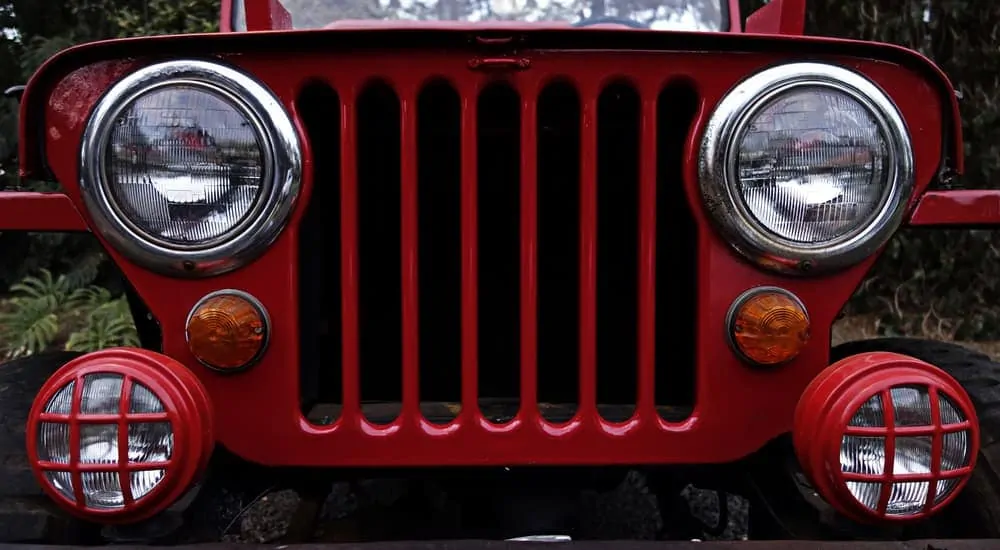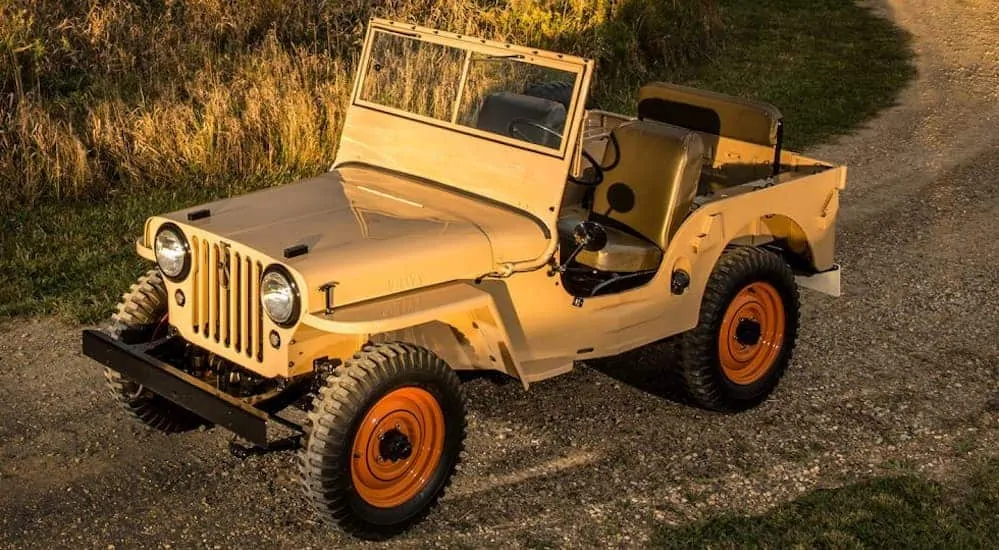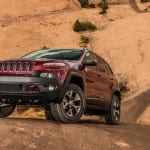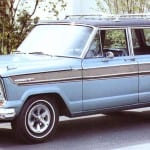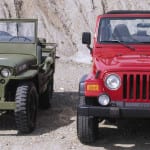When one struggling Pennsylvania car manufacturer designed a vehicle to withstand battle, the practical design would change the car industry forever. Without delving into the usefulness of the Jeep in WWII, the Korean War, and Vietnam, the Jeep’s significance to the world began with the first vehicles made for civilian use. Today, we see modern-day designs in our new and used Jeeps inherited from those designed before 1950.
After Japan surrendered, the brunt of the Allied effort in World War II was over. Soldiers rushed home to their families, and the Jeeps that saved them were forgotten. Willys-Overland, the main contracted manufacturer of the war vehicle by the U.S. Army, did not want to let go of their golden goose just yet. Thus begins the American infatuation with the circle-eyed, slotted grill of a Jeep.
Jeep’s First Civilian Vehicle and the CJ Series
For reference, the “Jeep” name would not become a registered trademark of Willys-Overland Motors until 1950.
Willys made small modifications to the Willys MB (the latest model of the military Jeep as of 1945), and moved the first-ever Jeep manicured for civilian hands into production in 1945. The CJ series is known best for maintaining the classic Jeep image we are all familiar with. These models would evolve eight times, and eventually welcome-in the Jeep Wrangler in 1987.
1945-1949: Willys-Overland CJ-2A
In order to make it attractive to customers, the Jeep barely needed to change. It already had the foundation and reputation of a workhorse, but it needed to be more comfortable for the user. Changes included a khaki exterior paint job, cushioned seats, larger headlights, automatic windshield wipers, a taller windshield, and a tailgate. The CJ-2A was powered by the same engine the military Jeeps utilized. This 4-cylinder, 60-68 hp engine, with 105-109 lb-ft of torque, went by the name, “Go-Devil.” The number of open grill slats moved from 9 to 7 on the CJ-2A, initiating the classic, 7-slot style.
1949-1953: Willys-Overland CJ-3A
Willys-Overland ended production of the CJ-2A when they had developed a more versatile Jeep. The CJ-3A gained a thicker rear axle and a smoother manual transmission. The Jeep’s new windshield featured one sheet of glass instead of two separated by a divider. A panel for ventilation was also installed underneath the windshield.Two years after the CJ-3A began production, Willys-Overland developed the Jeep Tractor. The Tractor was a CJ-3A with fewer passenger comforts and more capabilities to help make a farmer’s job easier. This Jeep Tractor lacked the necessities to be a daily driver (headlights, passenger seats, etc.), but contained heavy-duty springs, a hydraulic lift, and engine governor. The CJ-3A was discontinued in 1953.
1953-1964: Willys Motors CJ-3B
In 1953, Willys-Overland was purchased by the Kaiser-Frazer Corporation (or Kaiser Motors), so as new models were introduced, the name was changed to Willys Motors. The CJ-3B was very similar to the CJ-3A, but featured the new F-Head Hurricane engine. The new engine provided better performance, horsepower, and fuel economy. A higher hood was also added, giving it a different look than the previous model.
1955-1983: The Willys (Jeep) CJ-5
The war effort in America was spurred again when US Troops entered Korea in 1950. Due to continued military use, advancements in ride quality, engine performance, and comfort would come to the American’s driveway in 1955. The Willys name stuck around until 1964 for both the CJ-3B and CJ-5, but the CJ-5 continued in production as ‘Jeep’ after 1964.
The all-new CJ-5 was the most Jeep-esque model one could buy at the time to what we know of the Wrangler today. One of the CJ-5’s more personable touches were the available color options and the new, more rounded body shape. Underneath the hood, the CJ-5 featured the Hurricane engine, which had 25% more horsepower and 9% more torque than the Go-Devil. The wheelbase was extended and the shocks reinforced for a more capable off-road experience. Seat appointments included more cushion and more durable fabric. While 7 slots remained on the grill of the CJ-5, the grill façade was shortened in order to afford larger headlights with chrome casings.
The CJ-5 had several engine and design changes over the decades as the company grew and changed ownership. Kaiser gained rights to a Buick 3.7 L V6 Dauntless motor in 1965, which improved the CJ-5’s performance when supplemented to the 4-cylinder Hurricane. American Motors (AMC) took over ownership in 1970, which brought about two new replacement engines in 1972 that required a slight increase in the sizes of the fender, hood, and wheelbase. A full-floating Dana 30 front axle was also implemented. Technological improvements were also made as a factory-installed radio (1973), air conditioning through the dealership (1975), and electronic ignition for the full engine line-up became available.
1955-1981: CJ-6
The CJ-6 was created to offer CJ-5 lovers an option with more cargo space, as many did not want to switch to the station wagon style of the Willys Wagon (1946-1964). The wheelbase on the CJ-6 was extended 20 inches. Without a rear seat, this Jeep was a hauler’s best friend. The CJ-6 also came standard with the Go-Devil engine, but featured the same upgrades in 165 and 1972 that the CJ-5 was given. Jeep ended the production of the CJ-6 in 1981.
1976-1986: Jeep CJ-7
The CJ-7 design marked notable changes in the CJ series. Instead of being altered from the CJ-6 series, the CJ-7 was designed from the CJ-5 series. It featured a longer wheelbase than the CJ-5 (not longer than the CJ-6) because it came standard with an automatic transmission. The door frames were more rounded, compared to the more angled frames of the CJ-5. The CJ-7’s popularity caused Jeep to discontinue the production of the CJ-5. The CJ-7 also came with a number of engine options over the years, including a 5.0 L AMC V8 and a 2.4 L diesel (from 1980-1982 for export only). This model was extremely popular and had almost 400,000 built during its run.
1981-1985: Jeep CJ-8 Scrambler
The CJ-8 Scrambler was a small, two-seater pick-up truck styled model. Designed with the same frame of mind as the CJ-6, developers made this CJ longer, with the CJ-8 Scrambler being more than 22 inches longer than the CJ-7. It came with an optional hard or soft top, and a 4- or 6-cylinder engine. Although not too popular at the time of production, this Jeep-styled pickup is a hot collector’s item today.
1946-1964: Willy’s Wagon
Heading back in time and away from the CJ Series, we find the Willys Wagon. Willys-Overland wanted to create another Jeep option for America. As long as they recreated a different frame around their chassis, they knew there was potential to widen the consumer base. In 1946, Willys Wagon hit the production floor. It lacked four-wheel-drive until 1949, but featured excellent covered cargo space.
Willys Wagon was considered a station wagon, although, in pictures, it is very reminiscent of an SUV. The wagon shined because of its versatility. Six of the seven seats were removable, creating a spacious cargo area for just the driver. Thus, the wagon was popularly used as a family car and a delivery truck. Other uses were for those that needed to transfer cumbersome loads that could not get wet (otherwise, why not buy a pick-up truck?).
The all-steel component to the car added even more of an upside than comparable station wagon models. Other station wagons of the era were made with wooden bodies., decreasing the safety and durability of the vehicle. The all-steel component to the wagon coincided with the Willys mission, which allowed it to get dirty and keep its passengers safe.
Willys and Jeep Pickup Trucks
From 1947 to 1992, Willys-Overland/Jeep had constantly been producing and devising new and existing models of pick-up trucks.
1947-1964: The Willys-Overland Truck
Willys-Overland continued its campaign to reach each and every customer’s needs with the Willys-Overland Truck. This vehicle was ahead of its time. First developed in 1947, the Truck was available in four-wheel drive. Neither Ford nor Chevrolet had adopted this option on their trucks until roughly one decade later.
The truck gained a longer wheelbase than the Wagon and CJ, which yielded an obvious higher payload and cargo capacity in the bed. It came standard with the 60-68 hp engine, with 105-109 lb-ft of torque in the Go-Devil engine. It also came with an available rear cab (known as an extended and crew cabs today), for a more family-centric vehicle.
1962-1987: Gladiator and J Series Trucks
After the Willys-Overland Truck, came the Gladiator or J Series line of full-size pickup trucks. Jeep Gladiators came standard with the engine known as the “Tornado.” The Tornado was a six-cylinder engine capable of 140 hp and 210 lb-ft of torque. Gladiators came available with automatic transmission and independent front suspension for the most comfortable ride of any pick-up truck at the time.
The Gladiator name was dropped after 1971, but Jeep continued to produce trucks into 1987. The truck became known as the J Series or Jeep Pickup when AMC took over. Many engines were available over the years, including a V8 capable of 250 hp and 340 lb-ft of torque.
The Lasting Impact of the Jeep Pickup
Two more J-Series pick-up truck models (The J-10 and J-20), and one more pick-up named the Jeep Comanche would lead to Jeep’s pickup production to a halt in 1992. For the 2020 model year, Jeep has brought back the Gladiator pickup truck, which is already proving to be very popular. With the same exterior cab design as the Jeep Wrangler, the all-new Gladiator is sporting design elements reminiscent of the first Willys-Overland Truck.
Jeep’s Classic Roadster
One more model worth noting is the Jeepster. The Jeepster was a short-lived experiment by Willys-Overland from 1948-1950. The manufacturer had provided a dependable product for the American working-class by 1947 and wanted to dip into the young-adult market with the Jeepster. The Jeepster was a convertible with white-wall tires, no passenger windows, and only rear-wheel-drive. In its opening year, it featured the 4-cylinder Go-Devil engine.
In the next two years, the Jeepster’s drivetrain would improve, but not well enough to compete in the market for classy and excitingly fast roadsters. With more chrome than ever, two-wheel-drive, an angled grille, whitewall tires, no passenger windows, and hubcaps, the exterior of the Jeepster was the first Willys vehicle that did not resemble a Jeep. The Jeepster experienced little sales success, and production was ceased for 1951.
